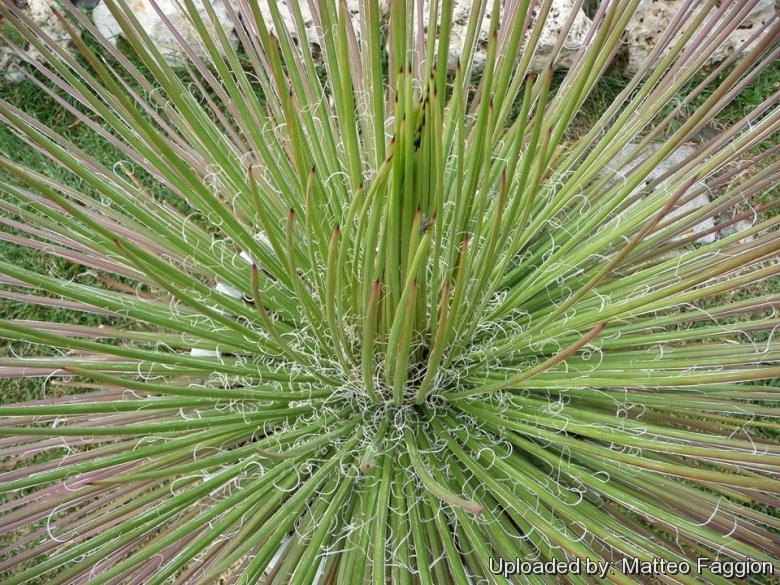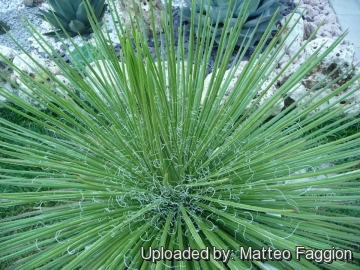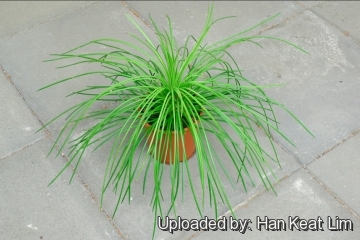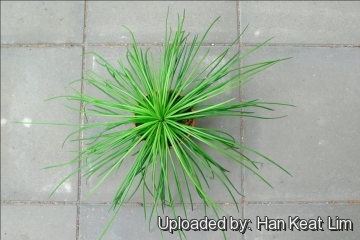
Agave geminiflora Photo by: Matteo Faggion
Origin and Habitat: Agave geminifloraSN|32183]]SN|32183]] is only known from one small area near Nayarit, 3-16 km north of Ocotillo, Mexico.
Altitude range: This species grows at 1,000 to 1,400 metres.
Habitat and ecology: The native habitat of Agave geminifloraSN|32183]]SN|32183]] is oak woodlands, where it is scattered along the rocky arroyos or with grass on rocky ground among the deciduous attractive oaks as well. This area has an equable climate with around 1,000 mm of annual rainfall from summer to winter followed by a dry spring.
Synonyms:
See all synonyms of Agave geminiflora
back
Accepted name in llifle Database:Agave geminiflora (Tagl.) Ker Gawl.Brande, Journ. Sc. 3: 3 (1817)Synonymy: 12
back
Common Names include:
ENGLISH: Twin-flowered Agave, Twin Flowered Agave, Spaghetti Strap
Description: Agave geminifloraSN|27920]]SN|32183]] (Twin-flowered Agave) is an single, short-stemmed, monocarpic agave with narrow, dark green unarmed leaves that are very flexible. These leaves, which often number 100-200, cascade from the centre of the plant forming a very symmetrical, compact, dense rounded solitary rosette to 60-100 cm tall and somewhat broader. When plants mature they will initiate flowers which are formed in pairs on an unbranched spike that rises 2.5-6 metres. The flowers are 5 or 6 centimeters long. Similar to Agave filiferaSN|10450]]SN|10450]] subsp. multifilifera but Agave geminiflora has more rounded leaves and fewer hairs on the leaf margins. It is most closely related to Agave ornithobromaSN|32183]]SN|27920]]. Selections have been made of this species that have fibrous silvery hairs that curl back along the margins (Thread-leaf form).
Derivation of specific name: The species name 'geminiflora', meaning "twin flowered" is in reference to the flower pairs.
Stem. Short - stemmed or stemless, branching when old.
Leaves: Many (100 -200) in a dense rosette, linear, stiff, flexible, dark green, 45-60 cm long, 6-8 m borad, pliant, eventually arching, smooth, roundly convex on both sides, abruptly acute, the margin with a fine, white horny line, finely filiferous (with curled threads) or rarely nonfilifemus, without spines. Apical spine 5-7 mm long, short-subulate, three-angled, greyish.
Inflorescence: Scape 2.5-6 metres tall, tapering, stout at base (9-12 cm diam.), long tapering, flowering in upper 2/3-3/4; bracts narrow.
Flowers: 40-52 mm long, greenish below, flushed above with red or purple, mostly geminate (twin flowered) on slender forched pedicels 5-8 mm long. Ovary 16-20 mm long, slender, neck grooved. Tube 6-11 mm deep, narrowly funnelform. Tepals greenish below, flushed above with red or purple, lobes slightly unequal, 18-21 long, 4-5 mm wide, linear-lanceolate, the inner slightly shorter, distinctly keeled. Filaments 35-46 mm long, colorless or reddish, inserted on rim of tube. Anthers 20-22 mm long.
Fruits (capsules): 18-20mm long, 9-10 mm broad, trigonous, oblong, short-pedicellate, short-beaked, tough, persistent.
Seeds: 3-4 mm long, 2-3 mm broad, lunate, thick, irregularly veined on faces, with expressed marginal wing.
Bibliography: Major references and further lectures
1) Howard Scott Gentry “Agaves of Continental North America” University of Arizona Press, 01 February 2004
2) Urs Eggli “Illustrated Handbook of Succulent Plants: Monocotyledons” Springer Science & Business Media, 17 July 2001
3) San Marcos Growers contributors “Agave geminiflora - Twin-flowered Agave” San Marcos Growers <http://www.smgrowers.com>. Web. 01 January 2016.
4) Monrovia (Azusa California USA), “Twin Flowered Agave Agave geminiflora” <http://www.monrovia.com/plant-catalog/plants/636/twin-flowered-agave/> Web. 01 January 2016
5) Wikipedia contributors. "Agave geminiflora." Wikipedia, The Free Encyclopedia. Wikipedia, The Free Encyclopedia, 12 Jul. 2014. Web. 2 Jan. 2016.
6) Hermann Jacobsen “Abromeitiella to Euphorbia” Blandford Press, 1960
7) Hermann Jacobsen “A Handbook of Succulent Plants: Descriptions, Synonyms, and Cultural Details for Succulents Other Than Cactaceae”, Volume 1 Blandford Press, 1960
 Agave geminiflora Photo by: Matteo Faggion
Agave geminiflora Photo by: Matteo Faggion Agave geminiflora Photo by: Han Keat Lim
Agave geminiflora Photo by: Han Keat Lim Agave geminiflora Photo by: Han Keat Lim
Agave geminiflora Photo by: Han Keat LimSend a photo of this plant.The gallery now contains thousands of pictures, however it is possible to do even more. We are, of course, seeking photos of species not yet shown in the gallery but not only that, we are also looking for better pictures than those already present.
Read More... Cultivation and Propagation: Agave geminifloraSN|32183]]SN|32183]] is a versatile hardy plant perfect for for small drought-friendly gardens and simple modern styles, it can be grown in half-shade to full-sun. It can take light freezes , and is extremely drought tolerant, but looks better with some summer watering. In winter watering this plant can be done once every 1-2 months, there is no need to mist the leaves. Agave geminifloraSN|32183]]SN|32183]] is theoretically hardy to -3° C, particularly when dry - but it is best to avoid severe freezing temperatures. Heat Tolerance: Excellent
Propagation: Seeds or suckers (if available). Although this species is noted to not produce offsets, as the main plant dies after flowering, a few new suckers occasionally emerge from within the old foliage. Remove these suckers in spring or summer, and let the cuttings dry for a few days before inserting in compost.













